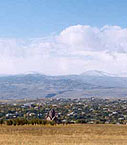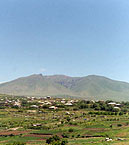|

|
Ohanavan
was resettled by migrants from Mush in 1828.
Perched on the Kasakh gorge rim, Hovhannavak
is a major monument from the 7th c. and later, the best docummented of the major Armenian
monasteries due to a manuscript of pious history
compiled in 1686 by the
Archdeacon Zakaria.
The |
|
Ushi
was, until
the Russian conquest in 1828, the administrative center of
the Mahal of Sayyidli- Aksakhli, encompassing the mountain slopes inhabited by the Turkic tribes of those names.
Entering the village opposite the turn-off for Hovhannavank
and taking the paved fork right, one
bumps W past a small
|

|
|
monastery was
dedicated to John the Baptist, and has a 12th
c. fortification wall with towers to the W, a 13th c. church
and gavit (a rebuilding financed in part by Kurd Vachutian), and an
early single-aisle church. The monastery has rich stone decoration, and many inscriptions.
|
|
10th
c.
church and reaches in about 1 km the badly ruined S. Sargis Vank and 7th c. shrine on a hill-side with a
splendid view. Work is under way to lay clear the collapsed 13th c.
church and adjacent gavit.
The complex is surrounded by a fortification wall of 1654. There is an
Iron Age fort atop the hill nearby. |